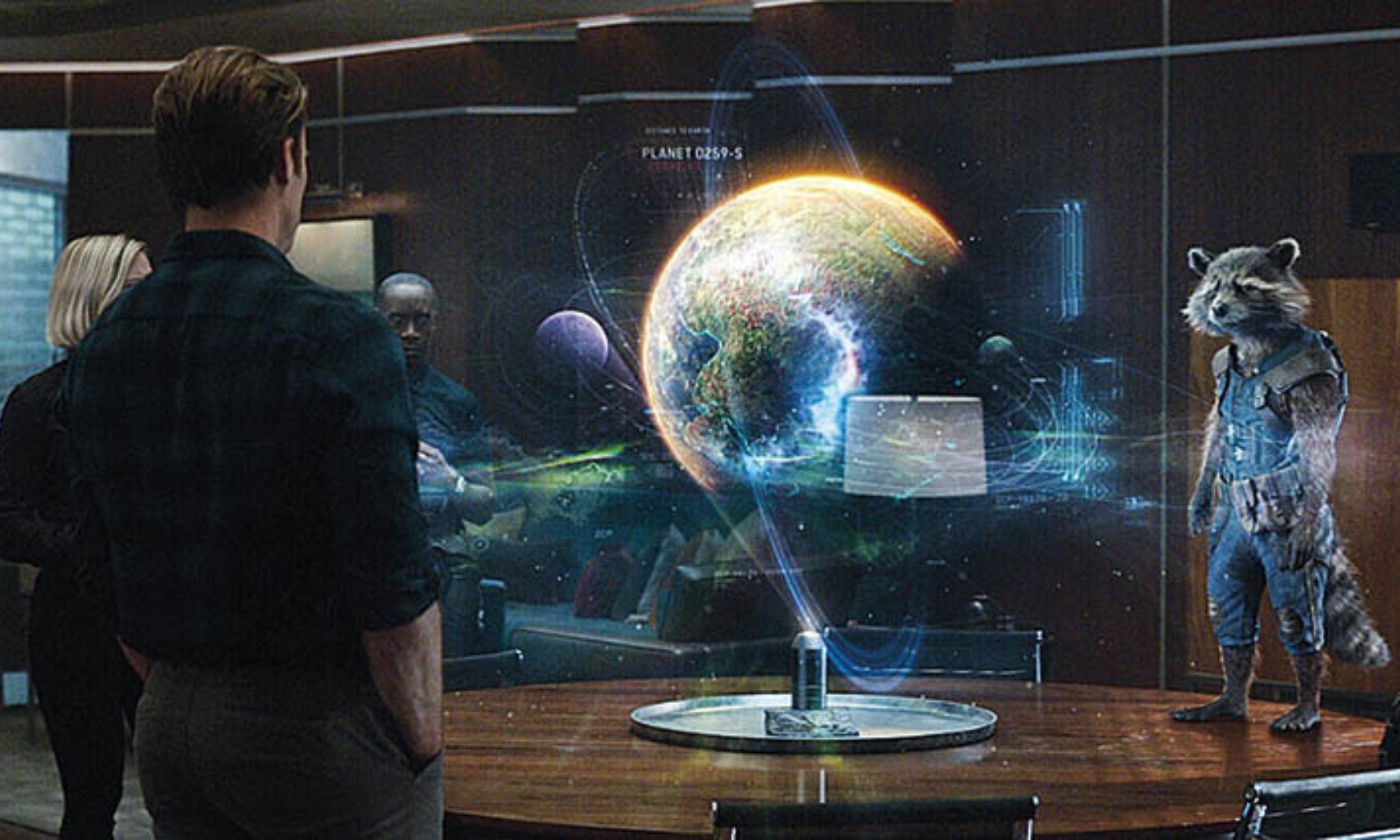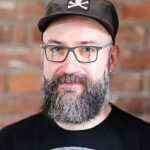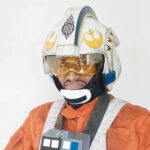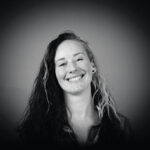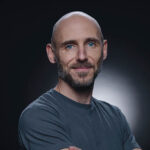Chanter les louanges des héros méconnus
01.01.70En vedette dans VFX Voice

La question qui prévaut pour Aaron Eaton en ce qui concerne les hologrammes est de savoir comment faire en sorte que quelque chose qui n’existe pas ressemble à quelque chose qui pourrait être capturé par une caméra, comme celui-ci présenté dans Avengers : Endgame.
(Image reproduite avec l’aimable autorisation de Cantina Creative et Marvel Studios)
Pour avoir une perspective plus micro, on peut regarder la section des effets visuels où des centaines et des centaines de noms sont répertoriés pour chacun des fournisseurs, et c’est là que l’on comprend vraiment le nombre de héros méconnus qui ont donné de leur temps et de leurs talents loin des projecteurs du public.
Ce manque de sensibilisation se produit également dans l’industrie des effets visuels, car les généralistes ont cédé la place à des spécialistes plus isolés des contributions de leurs collègues d’autres départements.
Dans le but de remédier à la situation, plusieurs entreprises d’effets visuels ont été invitées à présenter des candidats méritant d’être reconnus pour leur professionnalisme et leurs compétences exemplaires.
Considérez ceux énumérés ci-dessous comme un petit échantillon de personnes et de professions qui sont essentielles pour rendre possible le spectacle visuel et la transformation invisible. Aaron Eaton, superviseur des effets visuels, Cantina Creative J’aime le fait que je ne sois pas spécialisée parce que je détesterais faire une seule chose toute la journée !
Je suis heureuse d’avoir trouvé Cantina Creative où je peux encore être généraliste même aujourd’hui.
Vous ne vous contentez pas de travailler sur un plan pendant une heure, de l’envoyer à quelqu’un et de ne plus jamais le revoir.
Je suis capable de travailler sur quelque chose, et cela peut être très personnel, et vous êtes impliqué à travers toutes les étapes ; C’était cool.
Le compositing est définitivement mon préféré.
C’est ce dernier effort créatif d’apporter quelque chose de plus à un plan qui le fait s’asseoir et avoir l’air génial.
Les hologrammes sont beaucoup plus délicats qu’il n’y paraît parce que vous travaillez sur quelque chose qui n’existe pas.
Comment rendre l’hologramme absolument crédible, comme si c’était quelque chose que vous pouviez filmer avec une caméra ?
Il y a de nombreuses choses qu’il faut pour que l’hologramme se sente intégré dans la prise de vue.
Il s’agit en grande partie d’imiter tout ce que fait l’appareil photo, avec beaucoup de profondeur dans l’élément, les éléments de texture, le bruit, le grain et les problèmes.
Toutes sortes de caractéristiques subtiles qui pourraient accompagner tous ces hologrammes, car un hologramme n’est peut-être pas parfait.
Vous devez penser à la technologie qui projette ou crée l’hologramme et à tous les aspects de la façon dont il fonctionnerait réellement.
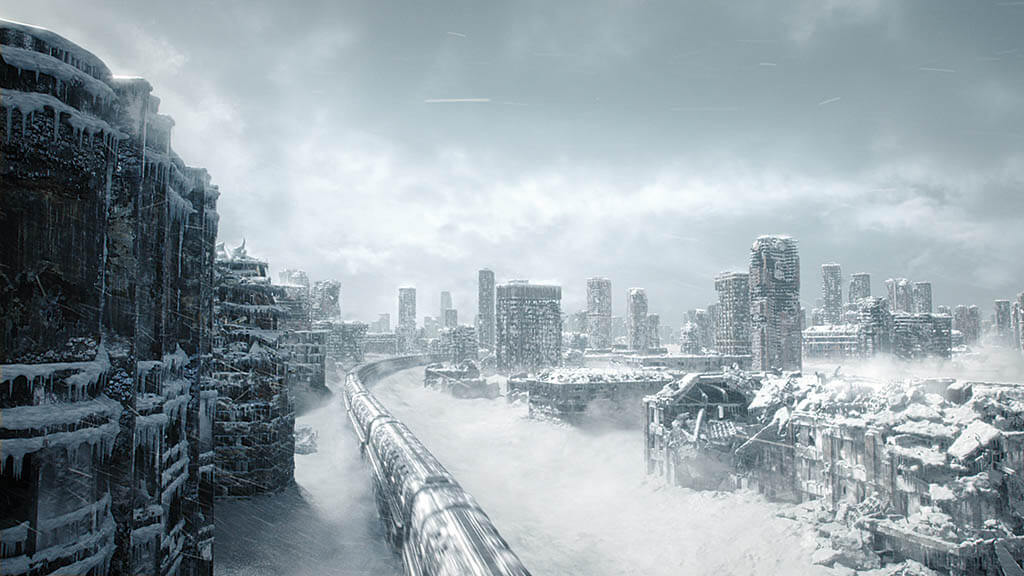
Comprendre la composition et la cinématographie était important pour Cameron Widen lorsqu’il a réalisé l’aménagement des plans extérieurs du train pour la saison 3 de Snowpiercer.
(Image reproduite avec l’aimable autorisation d’Image Engine Design et TNT)
Comprendre la composition et la cinématographie était important pour Cameron Widen lorsqu’il a réalisé l’aménagement des plans extérieurs du train pour la saison 3 de Snowpiercer.
(Image reproduite avec l’aimable autorisation d’Image Engine Design et TNT)
« Comme les flux de travail et les techniques évoluent constamment, il est pour moi plus important d’être au fait des questions qui ne changent souvent pas. Comment puis-je rester efficace pour être créatif ? Comment puis-je continuer à être inspiré et à inspirer ? Comment puis-je rester fier de mon travail ? » —Jason Martin, maquettiste, ILP
Alan Puah, responsable des systèmes, Territory Studio Systems est responsable de certaines des parties les plus critiques du pipeline, comme le stockage, le réseau et la ferme de rendu, qui constituent l’épine dorsale de l’infrastructure d’un studio d’effets visuels.
Parfois, l’infrastructure existante dicte le fonctionnement du pipeline, mais souvent c’est l’inverse qui se produit, et nous devons mettre à niveau et adapter les choses pour soutenir la structure d’un pipeline de projet.
La création d’images de synthèse impose des exigences parmi les plus élevées à la technologie utilisée, il est donc important de s’assurer que vous suivez les nouvelles technologies.
Il se passe probablement plus de choses aujourd’hui qu’à tout autre moment en ce qui concerne les progrès de l’apprentissage automatique et l’impact de la croissance exponentielle de la puissance de calcul sur notre industrie.
Mais il y a aussi eu un certain renversement de tendances.
Par exemple, dans certains cas, l’utilisation du cloud n’a pas été la meilleure solution, de sorte qu’il y a eu une migration vers le sur site pour diverses raisons, notamment la réduction des coûts ou le maintien d’un meilleur contrôle sur les données et la sécurité.

Cameron Ward a produit la prévisualisation de la séquence Black Panther : Wakanda Forever de Namora menant une escouade de Taloncail pour éliminer l’émetteur sonore du Royal Sea Leopard.
(Image reproduite avec l’aimable autorisation de Digital Domain et Marvel Studios)
Cameron Ward a produit la prévisualisation de la séquence Black Panther : Wakanda Forever de Namora menant une escouade de Taloncail pour éliminer l’émetteur sonore du Royal Sea Leopard.
(Image reproduite avec l’aimable autorisation de Digital Domain et Marvel Studios)
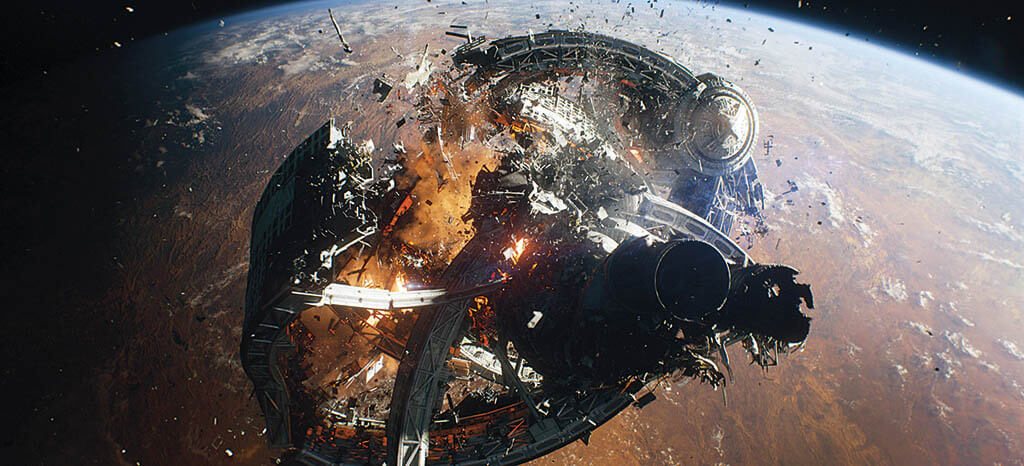
L’animation technique a dû être créée par Jason Martin pour la saison 2 de Perdus dans l’espace afin de soutenir les effets nécessaires aux tirs de destruction.
(Image reproduite avec l’aimable autorisation d’ILP et Netflix)
L’animation technique a dû être créée par Jason Martin pour la saison 2 de Perdus dans l’espace afin de soutenir les effets nécessaires aux tirs de destruction.
(Image reproduite avec l’aimable autorisation d’ILP et Netflix)

Jérémie Lodomez estime que le compositing est essentiel pour mélanger de manière transparente les images de synthèse, l’animation et les séquences d’action réelles, ce qui a été le cas pour la révélation de Heroes of the Horn dans la saison 2 de La Roue du Temps.
(Image reproduite avec l’aimable autorisation de Framestore et Prime Video)
Jérémie Lodomez estime que le compositing est essentiel pour mélanger de manière transparente les images de synthèse, l’animation et les séquences d’action réelles, ce qui a été le cas pour la révélation de Heroes of the Horn dans la saison 2 de La Roue du Temps. (Image reproduite avec l’aimable autorisation de Framestore et Prime Video)

C’est le livre L’Art du Seigneur des Anneaux qui a donné envie à Jeremy Melton de s’impliquer dans la construction du monde pour des séries telles que The Orville : New Horizons.
(Image reproduite avec l’aimable autorisation de FuseFX et Hulu)
C’est le livre The Art of The Lord of the Rings qui a donné envie à Jeremy Melton de s’impliquer dans la construction du monde pour des émissions telles que The Orville : New Horizons. (Image reproduite avec l’aimable autorisation de FuseFX et Hulu)
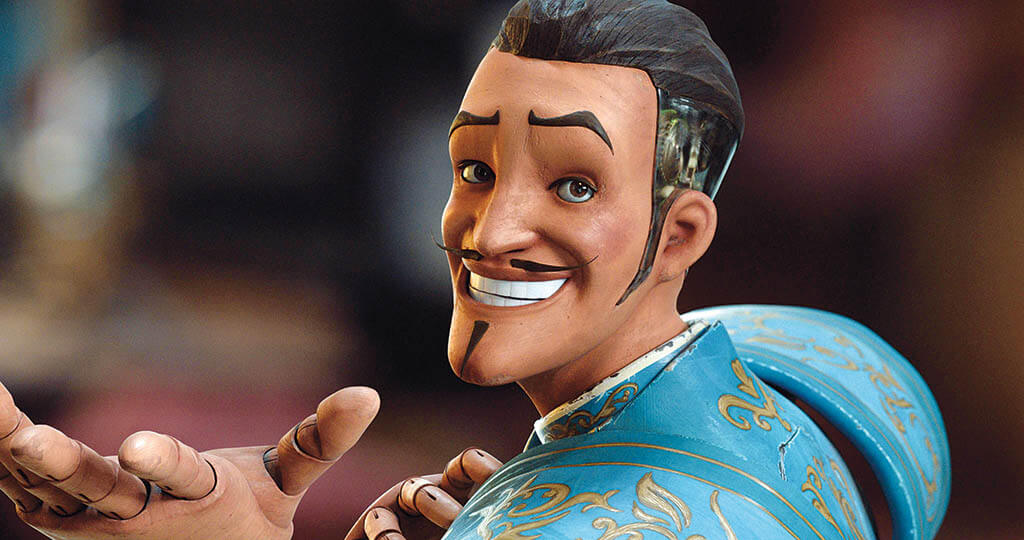
Pour Maike Fiene, il est important de ne pas être trop précieux sur la visualisation, car les besoins d’une production comme Jingle Jangle : A Christmas Journey évolueront au fil du temps.
(Image reproduite avec l’aimable autorisation de Framestore et Netflix)
Pour Maike Fiene, il est important de ne pas être trop précieux sur la visualisation, car les besoins d’une production comme Jingle Jangle : A Christmas Journey évolueront au fil du temps.
(Image reproduite avec l’aimable autorisation de Framestore et Netflix)
Alicia Carvalho, gréeuse principale, DNEG Je décris globalement mon travail aux personnes qui ne sont pas dans les effets visuels comme « mettre en place les structures de contrôle pour que les animateurs puissent animer.
« Venant principalement de l’animation, de la télévision et des cinématiques de jeux, travailler dans un pipeline d’effets visuels a été une expérience vraiment intéressante, surtout lorsque vous travaillez sur des plates-formes où le résultat final doit correspondre à une plaque.
Vous avez une autre couche de restrictions sur ce qui peut bouger et de quelle manière par rapport à la liberté relative que vous avez dans Feature lorsque les limites de ce que vous pouvez faire sont basées sur les besoins/l’imagination d’un animateur.
Avec l’apprentissage automatique et l’intégration des moteurs de jeu, il sera plus important pour les artistes de conserver leurs compétences fondamentales.
En général, j’ai remarqué une tendance prometteuse parmi les entreprises qui discutent et souhaitent placer davantage de collègues féminines dans des rôles de supervision ou de direction, mais il ne semble pas y avoir suffisamment de soutien de mentorat une fois que ces postes sont pourvus.
Il y a toujours place à l’amélioration. Cameron Ward, artiste de prévisualisation, Digital Domain J’étais sur Black Panther : Wakanda Forever, et il y avait de magnifiques rendus du bateau alors que les bombes hydroélectriques continuaient d’arriver et d’exploser en dessous.
Nous avions un peu de temps pour pouvoir le composer et le rendre beau avant de le livrer au client, mais ce n’est pas toujours le cas.
Cela dépend du projet et de ce que le client exige, car parfois, ils ne recherchent que du brut.
Cependant, parfois, l’éclairage et la composition peuvent vendre une photo.
Il y a des années, j’étais sur The Fate of the Furious, et nous sommes allés chercher des scans de la ville.
Nous étions en train de tracer les rues et les hauteurs des bâtiments.
Nous avons pris une Dodge Challenger et monté une caméra sur son capot.
Quand le jour du tournage est venu, ils n’ont pas payé les services d’artisanat pour quatre jours de tournage, mais pour un seul parce qu’ils ont tout obtenu en une journée.
Il y a aussi cet aspect.
Vous réduisez le coût d’une journée de production réelle parce que vous connaissez déjà l’angle de votre caméra, la distance focale, la hauteur à laquelle vous voulez que la caméra décolle du sol et la vitesse à laquelle elle ira. Cameron Widen, Mise en page, Moteur d’image Le mot « layout » a une signification différente pour chaque studio – et souvent pour chaque personne avec qui vous parlez dans un studio.
La mise en page dans l’animation de longs métrages est beaucoup plus impliquée dans des tâches de type prévisualisation, comme la détermination des angles de caméra et de la composition.
Dans les effets visuels, la plupart du temps, nous travaillons avec des plaques qui ont été tournées, donc il n’y a pas beaucoup de choix à faire par rapport à cet égard.
Cela dit, dans presque tous les projets, il y aura des prises de vue en images de synthèse qui n’ont pas de photographie associée, et c’est là que nous pouvons faire travailler nos muscles créatifs et utiliser nos compétences en composition et en cinématographie.
Récemment, nous avons reçu un coup de pouce pour donner à nos versions de mise en page et à la présentation que nous envoyons pour examen un aspect beaucoup plus agréable que ce que j’ai l’habitude de faire.
Ma préférence est d’envoyer des rendus grisés pour examen, car les gens commenteront alors la composition, la vitesse de l’appareil photo et le cadrage de l’appareil photo. Si nos versions de mise en page ont l’air trop belles et polies, nous commencerons à avoir des superviseurs d’effets visuels ou d’autres personnes qui verront un problème avec une carte de texture ou un ombrage sur lequel nous n’avons aucun contrôle, et ils se fixeront là-dessus et ne feront aucun commentaire sur la partie mise en page.
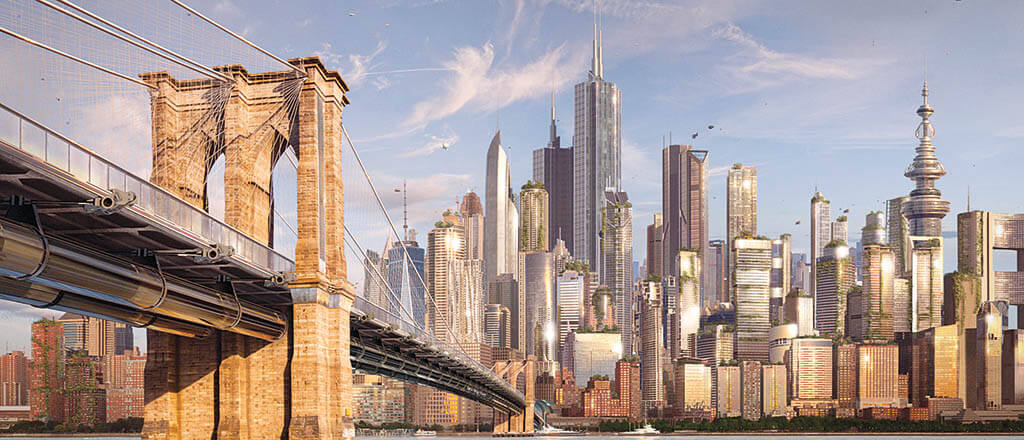
Meliza Fermin a créé un pont futuriste de Brooklyn pour The Orville.
(Image reproduite avec l’aimable autorisation de FuseFX et Hulu)
Meliza Fermin a créé un pont futuriste de Brooklyn pour The Orville. (Image reproduite avec l’aimable autorisation de FuseFX et Hulu)
En tant que superviseur du flux de travail, Michael Billette passe du temps à informer les différents départements d’Image Engine sur la meilleure façon d’utiliser le pipeline lorsqu’il travaille sur des projets comme Bloodshot.
(Image reproduite avec l’aimable autorisation d’Image Engine Design et de Columbia Pictures/Sony)
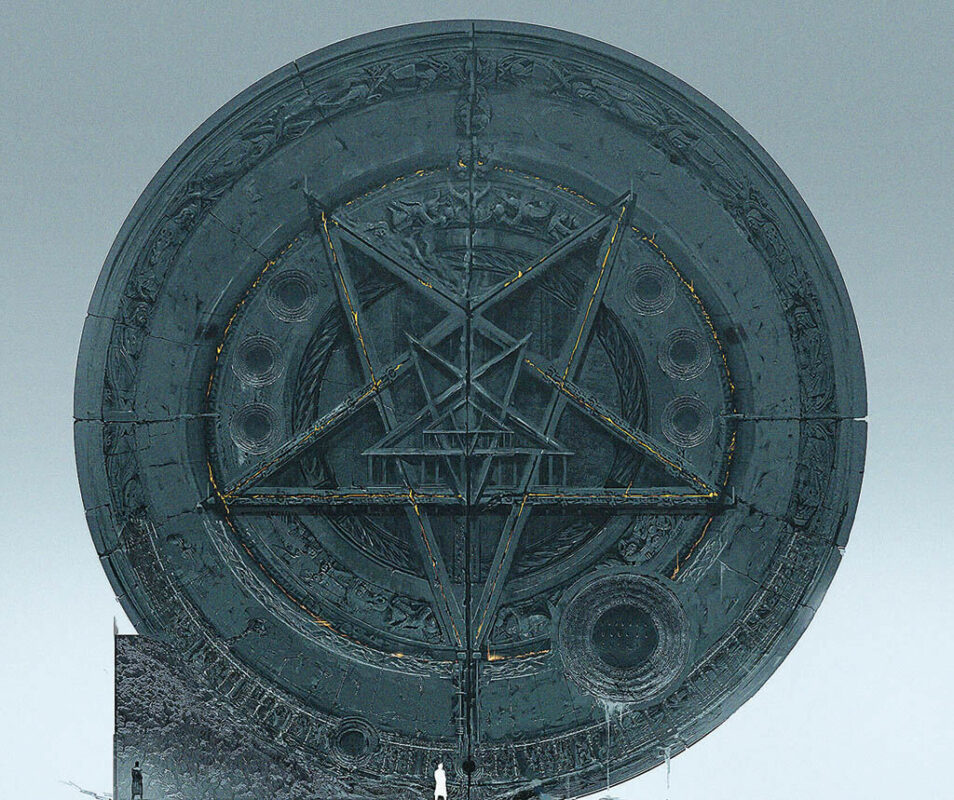
Concept art de la porte du palais de Lucifer par Niklas Wallén pour la saison 1 de The Sandman.
(Image reproduite avec l’aimable autorisation d’ILP et Netflix)
Concept art de la porte du palais de Lucifer par Niklas Wallén pour la saison 1 de The Sandman. (Image reproduite avec l’aimable autorisation d’ILP et Netflix)
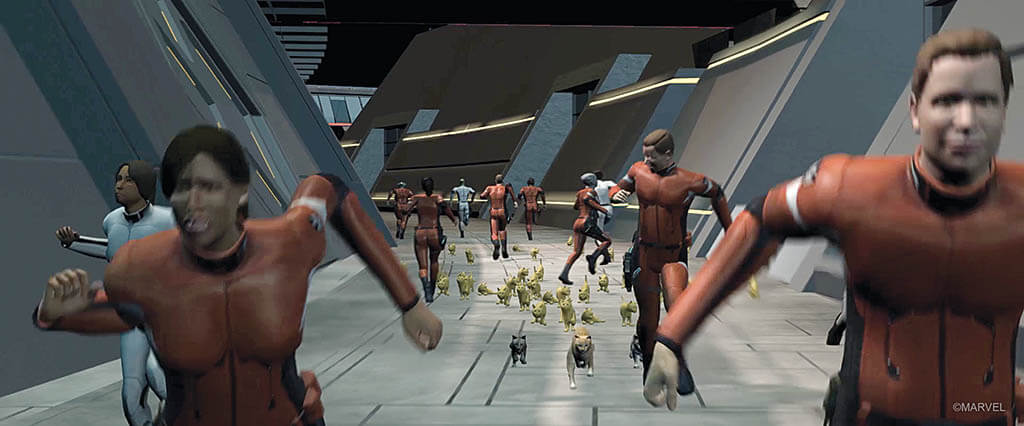
Pendant la pré-production et la post-production de The Marvels, Patrick Haskew a fourni une visualisation qui a été utilisée pour aider à transmettre toute une équipe engloutie par Flerkens.
(Image reproduite avec l’aimable autorisation de The Third Floor et Marvel Studios)
Pendant la pré-production et la post-production de The Marvels, Patrick Haskew a fourni une visualisation qui a été utilisée pour aider à transmettre toute une équipe engloutie par Flerkens.
(Image reproduite avec l’aimable autorisation de The Third Floor et Marvel Studios)
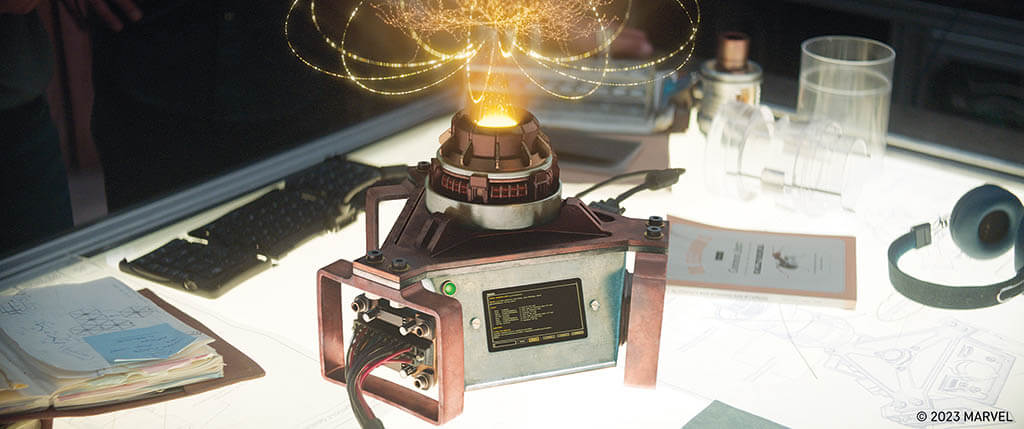
Une grande partie du travail de Sam Keehan consiste à fournir le soutien nécessaire pour que les artistes puissent se concentrer sur leur travail et produire les meilleurs résultats pour des clients comme Marvel Studios sur Ant-Man et la Guêpe : Quantumania.
(Image reproduite avec l’aimable autorisation de Territory Studio et Marvel Studios)
Une grande partie du travail de Sam Keehan consiste à fournir le soutien nécessaire pour que les artistes puissent se concentrer sur leur travail et produire les meilleurs résultats pour des clients comme Marvel Studios sur Ant-Man et la Guêpe : Quantumania.
(Image reproduite avec l’aimable autorisation de Territory Studio et Marvel Studios)

Les platines sont indispensables lors de la soumission de textures pour examen afin de s’assurer que l’image finale a la bonne réflectivité et la bonne déformation de surface, comme lorsque vous travaillez sur Shang-Chi et la légende des dix anneaux.
(Image reproduite avec l’aimable autorisation de Digital Domain et Marvel Studios)
Les platines sont indispensables lors de la soumission de textures pour examen afin de s’assurer que l’image finale a la bonne réflectivité et la bonne déformation de surface, comme lorsque vous travaillez sur Shang-Chi et la légende des dix anneaux. (Image reproduite avec l’aimable autorisation de Digital Domain et Marvel Studios)
George Sears, responsable de la production virtuelle, The Imaginarium Studios Essentiellement, mon travail consiste à m’occuper de toutes les technologies en temps réel sur notre scène, et cela va des personnages de base aux effets intégrés à la caméra en passant par les murs LED.
Nous avons également tendance à nous impliquer dans la pré-production en examinant les actifs, les choses que nous allons piloter en direct et ce que le réalisateur veut accomplir.
Ensuite, nous avons rassemblé un tas de technologies en temps réel que nous avons à notre disposition pour ce projet.
Je vois essentiellement le travail comme un lien avec l’animation, la capture de mouvement et les effets visuels pour les films, les jeux vidéo, la télévision, la RA et le Web.
Nous utilisons Unreal Engine 5 pour diffuser toutes nos données de capture de mouvement en direct, et c’est là que nous ferons les personnages en direct et les caméras virtuelles pour soutenir le réalisateur.
La principale raison pour laquelle nous faisons cela est que le client peut partir le jour même, avoir signé des plans, savoir exactement ce qu’il fait et ce qu’il apporte en post-production et, en fonction du flux de travail, parfois repartir avec un montage en temps réel.
Ils peuvent entrer dans la post-production en sachant qu’ils ont tout, ce qui permet généralement d’économiser beaucoup d’argent et de temps dans le processus de prise de décision.
De plus, je supervise notre pipeline et je dirige une équipe de R&D. Jason Martin, maquettiste, ILP Comme les flux de travail et les techniques évoluent constamment, il est pour moi plus important d’être au fait des questions qui ne changent souvent pas.
Comment puis-je rester efficace pour être créatif ?
Comment puis-je continuer à être inspiré et à inspirer ?
Comment puis-je rester fier de mon travail ? [One of the most complex tasks] serait quelque chose que nous appelons « Animation technique » que j’ai fait sur Perdus dans l’espace S1 et S2 pour soutenir les effets sur la tâche de destruction où de grands environnements ou des vaisseaux spatiaux s’effondrent ou sont détruits.
Je fournirais une version semi-détaillée de l’événement à effet, réalisée avec diverses méthodes dans Maya, comme l’animation d’images clés, la simulation rigide, la simulation de tissu ou la déformation, que des artistes d’effets talentueux amélioreraient, développeraient ou ajouteraient.
Ce flux de travail nous a permis de maintenir un haut niveau de contrôle artistique sur des équipes de petite taille souvent composées de moi et d’une à deux personnes, mais le nombre même le rendait complexe. Jérémie Lodomez, responsable mondial de la 2D – Film et épisodes, Framestore Le compositing joue un rôle essentiel dans le pipeline des effets visuels, en mélangeant de manière transparente des éléments tels que des images de synthèse, des animations et des séquences d’action en direct dans le résultat final.
Il améliore le réalisme et soutient la narration en veillant à ce que tous les éléments soient cohérents en termes d’éclairage, de perspective et de couleur.
Mon aspiration est que les compositeurs puissent effectuer des itérations rapides dans leur logiciel.
Par exemple, peaufiner un environnement CG sans s’empêtrer dans de longues révisions interdépartementales.
Cette approche permettrait des itérations créatives rapides, avec la possibilité d’intégrer ces correctifs dans les étapes ultérieures du pipeline.
L’essor de technologies telles que l’USD et l’Unreal Engine annonce un avenir où les compositeurs pourraient émerger comme des acteurs plus dynamiques dans le domaine, évoluant vers des artistes de composition d’images. Le fait que le public ne puisse pas discerner notre travail d’effets visuels en dit long sur la qualité et le réalisme que nous obtenons. Jeremy Melton, Superviseur du département artistique/DMP/Concept Artist, FuseFX J’ai vu The Art of The Lord of the Rings quand il est sorti, et j’ai été époustouflé.
En tant que superviseur artistique, j’essaie d’encourager tout le monde à être un artiste, à donner le meilleur de lui-même et à aller dans la direction qu’il veut prendre.
Ne pas cataloguer quelqu’un ou lui faire faire quelque chose qu’il ne veut pas faire.
Mais en même temps, il y a l’aspect corporatif qui consiste à s’assurer que les budgets et toutes les règles sont respectés, que nous faisons tout ce que nous sommes censés faire.
C’est fou.
Je n’ai jamais été formé à cela.
J’ai accédé à ce poste par expérience.
Vous devez être ouvert, surtout avec l’avènement de l’IA utilisant Blender ou ZBrush, tout ce qui aide l’artiste à se rendre là où il doit être pour créer la meilleure image possible.
C’est une chose que je veux encourager.
Au lieu de dire « C’est comme ça que c’est fait », ouvrons-le.
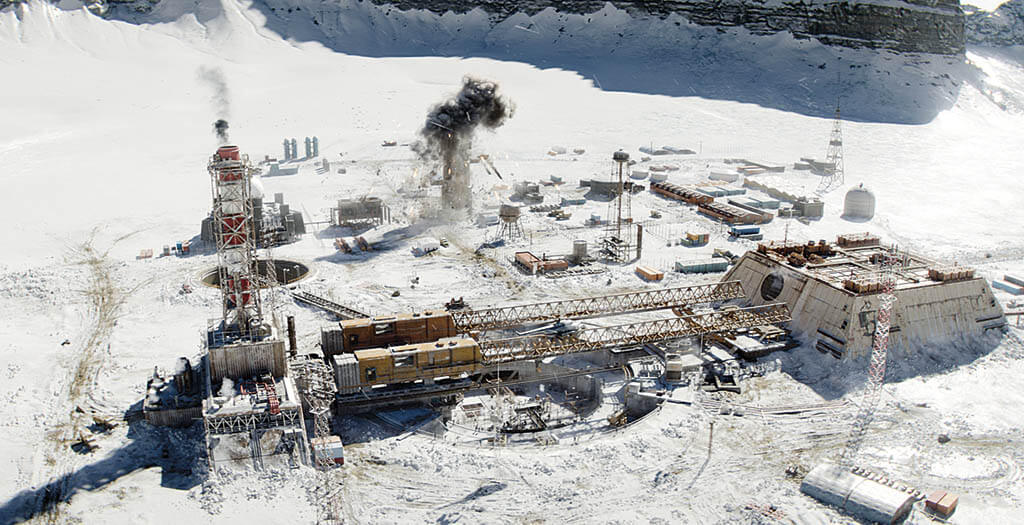
Thomas Mouraille estime que le terme « Environnement/Généraliste » est meilleur que « Matte Painter » car il décrit plus précisément le travail effectué pour les prises de vue du goulag
dans Black Widow.
(Image reproduite avec l’aimable autorisation de Wētā FX et Marvel Studios)
Thomas Mouraille pense que le terme « Environnement/Généraliste » est meilleur que « Matte Painter » car il décrit plus précisément le travail effectué pour les prises de vue du goulag dans Black Widow. (Image reproduite avec l’aimable autorisation de Wētā FX et Marvel Studios)
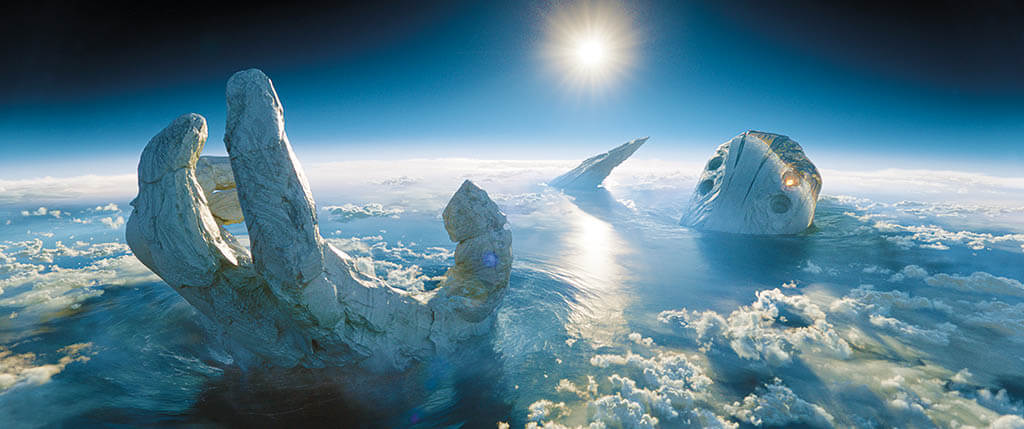
Thomas Mouraille utilise des logiciels 3D, tels que Maya, ZBrush et Substance, combinés à des éléments 2D créés dans Photoshop, pour produire des matte paintings pour The Eternals.
(Image reproduite avec l’aimable autorisation de Wētā FX et Marvel Studios)
Thomas Mouraille utilise des logiciels 3D, tels que Maya, ZBrush et Substance, combinés à des éléments 2D créés dans Photoshop, pour produire des matte paintings pour The Eternals. (Image reproduite avec l’aimable autorisation de Wētā FX et Marvel Studios)
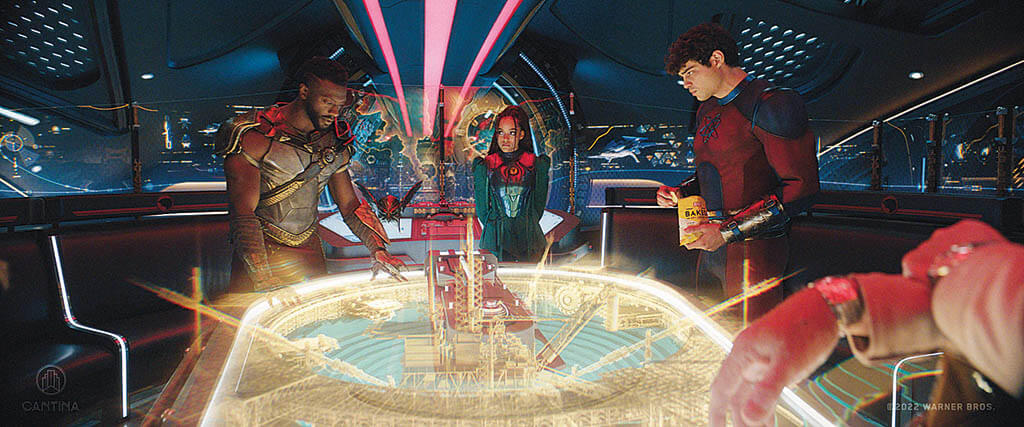
Lors de la création d’une technologie pour le grand écran, il faut garder à l’esprit comment cela fonctionnerait réellement, ce qui a été le cas pour Aaron Eaton lorsqu’il a travaillé sur Black Adam.
(Image reproduite avec l’aimable autorisation de Cantina Creative et Warner Bros. Pictures)
Lors de la création d’une technologie pour le grand écran, il faut garder à l’esprit comment cela fonctionnerait réellement, ce qui a été le cas pour Aaron Eaton lorsqu’il a travaillé sur Black Adam.
(Image reproduite avec l’aimable autorisation de Cantina Creative et Warner Bros. Pictures)
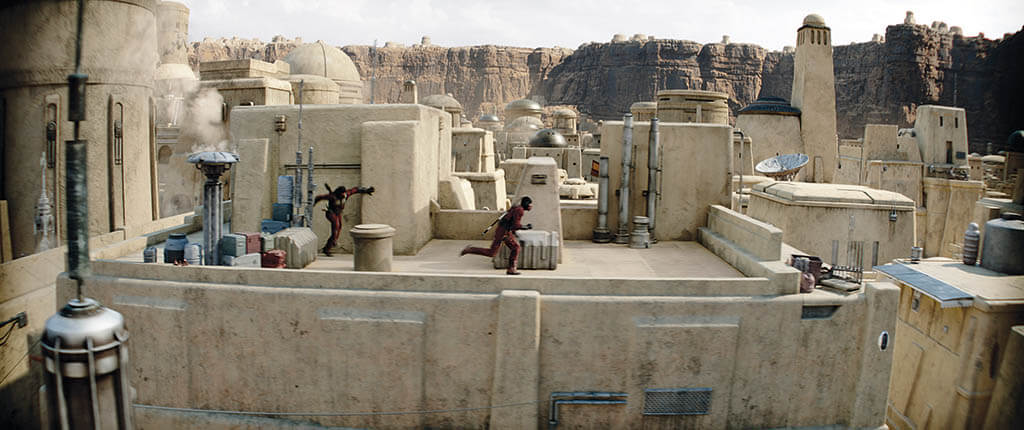
Lorsque vous travaillez avec de la photographie de plaques.
Cameron Widen a beaucoup moins de liberté créative pour la mise en page que lorsqu’il s’agit de plans CG complets, comme le reflète The Book of Boba Fett.
(Image reproduite avec l’aimable autorisation d’Image Engine Design et de Lucasfilm Ltd.)
Lorsque vous travaillez avec de la photographie de plaques.
Cameron Widen a beaucoup moins de liberté créative pour la mise en page que lorsqu’il s’agit de plans CG complets, comme le reflète The Book of Boba Fett. (Image reproduite avec l’aimable autorisation d’Image Engine Design et Lucasfilm Ltd.)
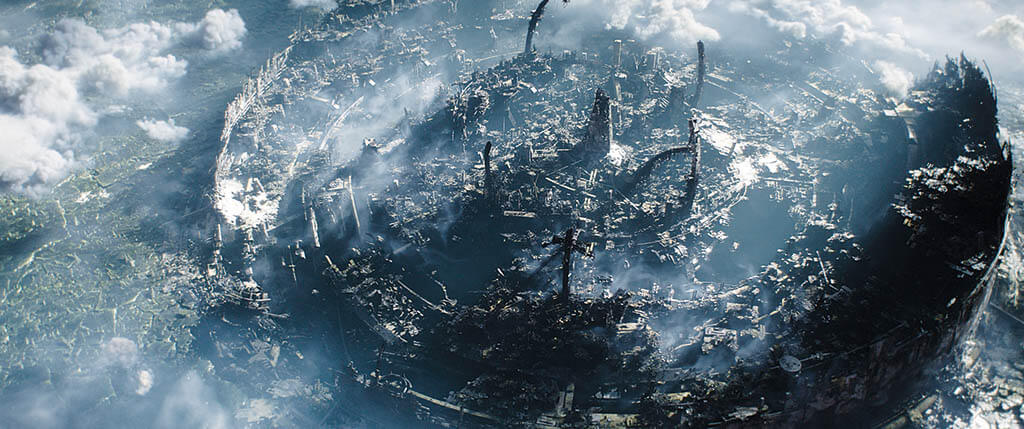
Il y a constamment des questions auxquelles Jason Martin essaie toujours de répondre, comme comment rester efficace afin d’être créatif lorsqu’il travaille sur une image de Sundari dans la saison 3 de The Mandalorian.
(Image reproduite avec l’aimable autorisation d’ILP et de Lucasfilm Ltd.)
Il y a constamment des questions auxquelles Jason Martin essaie toujours de répondre, comme comment rester efficace afin d’être créatif lorsqu’il travaille sur une image de Sundari dans la saison 3 de The Mandalorian. (Image reproduite avec l’aimable autorisation d’ILP et de Lucasfilm Ltd.)

En tant que superviseur du département artistique, Jeremey Melton doit également être conscient des restrictions budgétaires lorsqu’il travaille sur The Orville : New Horizons.
(Image reproduite avec l’aimable autorisation de FuseFX et Hulu)
En tant que superviseur du département artistique, Jeremey Melton doit également être conscient des restrictions budgétaires lorsqu’il travaille sur The Orville : New Horizons. (Image reproduite avec l’aimable autorisation de FuseFX et Hulu)
Katie Corr, animatrice faciale en chef et directrice technique de la capture faciale, The Imaginarium Studios C’est assez amusant de travailler avec beaucoup de clients différents parce que vous avez des projets réalistes qui utilisent des métahumains, et c’est l’un de nos pipelines.
Ensuite, vous avez des projets stylisés qui sont cartoonesques, et j’ai un peu plus de liberté avec ça.
Mon travail commence sur scène avec la capture, c’est-à-dire prendre soin des acteurs, m’assurer que le client est satisfait et capturer la date afin que l’équipe de post-production puisse s’assurer qu’elle obtient un bon résultat sur son suivi.
Ensuite, nous passons à autre chose et commençons à suivre l’un de nos pipelines.
À partir de là, nous l’emmenons sur leur plate-forme fournie et effectuons le nettoyage final selon leurs spécifications qui leur ont été demandées en fonction du jeu, du film, de l’émission de télévision ou de la publicité.
Tout ce à quoi vous pouvez penser, nous l’avons essayé !
Plus vous y consacrez de temps, plus sa qualité est élevée.
C’est un domaine assez subjectif.
Vous essayez de cerner de petites nuances comme des évasements nasaux ou lorsque quelqu’un respire ou de petites contractions oculaires.
La partie amusante du travail est que vous entendez la demande du client, puis vous vous mettez au défi, trouvez des moyens de la contourner et de maintenir ses attentes. Maike Fiene, superviseure de la visualisation, Framestore La visualisation étant la première étape pour montrer l’interaction avec les éléments CG, il est essentiel d’accepter qu’il y aura des changements dans le travail au fur et à mesure de son développement, et vous devez être capable de vous adapter et ne pas être trop précieux à ce sujet.
C’est également gratifiant car vous avez l’occasion de façonner l’interaction des moments amusants et doux des personnages.
Il s’agit d’un environnement au rythme très rapide qui nécessite un ensemble de compétences générales telles que : la compréhension des techniques de tournage pratiques ; être capable d’interpréter des storyboards et des scripts ; Vue d’ensemble et intention de la séquence sur laquelle vous travaillez (ton, timing, quel est le but de cette séquence dans le film ? Qu’est-ce que le réalisateur essaie de communiquer ?) ; Compréhension générale de la cinématographie (mise en scène, éclairage, composition) ; et des compétences techniques polyvalentes en matière de dépannage.
En postvis, nous collaborons souvent avec les équipes finales, car elles ont peut-être développé d’autres ressources ou des animations de personnages, et nous essayons d’en incorporer autant que possible pour rester fidèles à l’aspect final du projet.
Cela donne au réalisateur l’occasion de façonner sa vision des montages à un stade précoce et de tester des idées, et cela donne aux équipes finales une base solide sur laquelle commencer. Meliza Fermin, Matte Painter numérique en chef et Sr.
Compositeur En tant que matte painter, vous n’en êtes qu’au début du processus, et je préfère cela parce que vous avez plus de temps, c’est beaucoup plus créatif et vous choisissez plus d’éléments qui vont être utilisés.
Nos clients disent : « Je veux le New York des années 1960. » Vous devez créer cela, mais c’est moi qui choisis tous les éléments photographiques à assembler pour que cela fonctionne dans cet environnement.
Vous avez une contribution créative.
Certains studios me font faire le matte painting et le commode, ou j’ai travaillé là où j’étais strictement un matte painter et je le confie au compositeur.
Ce qui est bien avec les deux, c’est que je sais que les compositeurs vont rencontrer des problèmes ; J’ai déjà préparé le matte painting pour qu’il fonctionne et qu’il n’ait pas à me revenir.
Le compositing est plus technique que créatif.
Parfois, il n’y a pas de temps pour revenir à l’infographie ou au matte painting, vous devez donc trouver des moyens rapides de le réparer.
Vous êtes un résolveur de problèmes. Michael Billette, superviseur du flux de travail, Image Engine Design, Inc. Nous discutons constamment avec chaque service des défis de son travail quotidien, et nous réfléchissons à la façon dont les choses peuvent être améliorées et à la façon dont ils peuvent utiliser les parties du pipeline que nous avons déjà développées dont ils ne sont peut-être pas conscients ou ne comprennent peut-être pas comment elles pourraient être appliquées.
Nous essayons beaucoup d’enseigner aux gens comment utiliser les outils.
Ensuite, nous réfléchissons également à la manière dont nous pouvons améliorer nos processus et garder les choses synchronisées.
Nous ne pouvons pas faire grand-chose en tant que service d’assistance, et ce n’est pas nécessairement assez rapide pour ce dont les gens ont besoin sur le terrain.
Souvent, si les artistes développent leurs propres flux de travail ou outils, les choses deviennent très fragmentées très rapidement.
Chaque personne essaie de trouver sa propre solution et peut emprunter des chemins différents.
Nous essayons de garder les choses en ligne parce que c’est beaucoup plus facile pour les équipes techniques de se développer lorsqu’elles n’ont pas tous ces processus parallèles sur lesquels travailler.
Ils peuvent créer des fonctionnalités de base et s’assurer qu’ils peuvent prendre en charge les autres flux de travail nécessaires. Niklas Wallén, Concept Artist, ILP Vous devez avoir vos fondamentaux en tant qu’artiste conceptuel et quelques règles de conception que vous pouvez toujours appliquer pour le rendre plus beau.
Mais parfois, on me donne des choses et je me dis : « Je ne vois pas le problème ici. » Lorsque j’ai commencé chez ILP, mon mentor, Martin Bergquist, m’a dit : « Votre travail consiste à vérifier la direction artistique et les documents du client et ce qu’il avait en tête dès le départ, à être bon avec cela et à créer un livre de règles de conception. Mais ensuite, vous prenez ces règles de conception et vous vous amusez avec. Si vous avez toujours ces règles de conception en vous, il est facile de repérer quand quelque chose ne va pas avec une image.
Qu’il s’agisse de The Mandalorian ou de The Sandman qui ont des langages de forme totalement différents, je peux rapidement dire si c’est hors de propos parce qu’il y a généralement quelqu’un qui a construit le matériel, qui y est depuis longtemps, et peut-être qu’il s’est mis dans un terrier de lapin et a oublié ce qu’est le langage des formes. C’est mon travail d’y aller et de dire : « Cela fonctionnera mieux si je fais cela. » Patrick Haskew, superviseur principal de la visualisation, The Third Floor Visualization aide à jeter les bases de ce que vous voyez sur grand écran.
Parce que vous pouvez itérer rapidement et travailler en étroite collaboration avec de nombreux collaborateurs, y compris le superviseur des effets visuels, dès le premier jour de la production, le processus est inestimable pour aider à développer l’apparence des visuels en ce qui concerne la narration d’une histoire crédible.
Nous sommes également en mesure de fournir et d’utiliser des outils de visualisation technique et de production virtuelle qui aident à connecter ce qui est visualisé aux plans et à l’équipement sur le plateau, et à garantir que le travail et les plans de la pré-production se poursuivent et peuvent être développés par la post-production.
L’industrie essaie toujours de trouver un moyen de rendre le cinéma et la télévision moins chers et plus rapides, et nous sommes à l’avant-garde de cette entreprise.
Mais, en fin de compte, les relations établies avec les réalisateurs, les producteurs et les superviseurs VFX sont au cœur du processus.
La technologie changera toujours, mais tout commence par l’idée de raconter une histoire que le public adorera.
Nous sommes dans cette pièce et nous aidons à représenter cette vision de la narration. Patrick Smith, responsable de la visualisation, MPC Visualization est sorti de ses balbutiements et commence à entrer dans ses années punk-rock adolescentes.
Avec l’avènement de tous les outils et de la technologie en temps réel qui arrivent au premier plan avec la production virtuelle, la visualisation est certainement un élément clé de ce pipeline de réalisation de films en évolution, et elle met en lumière tout ce que nous faisons.
C’est parti comme une traînée de poudre.
Tout le monde et son frère ont maintenant un studio de visualisation, et chaque maison d’effets visuels intègre un département de visualisation en amont de son pipeline.
La façon la plus simple de comprendre la visualisation est de la comparer à la sculpture.
Imaginez que vous commenciez avec une plaque de marbre géante et que vous disiez : « Nous allons sculpter la statue de David. » Et tout le monde se demande : « À quoi cela ressemble-t-il ? » Ce que vous faites, c’est aider à développer et à façonner l’esthétique visuelle de cela. Vous pouvez considérer la prévisualisation comme votre brouillon, aller tourner, puis finaliser ce qu’est ce repêchage afin de préparer votre équipe finale pour réussir à la fin de celle-ci. Sam Keehan, directeur créatif, Territory Studio La chose la plus importante dans le métier de directeur créatif a toujours été d’essayer aussi souvent que possible – que ce soit lorsque nous recrutons des projets ou des personnes – de m’entourer de personnes qui sont meilleures que moi.
Il y aura des compétences particulières dans lesquelles les gens seront bien meilleurs que moi.
Nous pouvons parler, et ils peuvent aller profiter de ce qu’ils font vraiment bien et proposer des choses intéressantes.
Je serai capable de m’asseoir et de dire : "Oui. C’est exactement ce que je pensais. La difficulté inhérente est si vous avez plusieurs personnes sur plusieurs emplois.
Vous voulez vous assurer que tout le monde s’entraîne au mieux, mais les seules personnes qui s’entraînent le mieux sont celles qui reçoivent suffisamment de soutien.
Pour mon travail, en particulier, j’ai l’impression qu’il s’agit en grande partie de faciliter et de s’assurer que les gens ont le soutien dont ils ont besoin pour se concentrer sur le travail qui doit être terminé. Stuart Ansley, artiste principal des textures, domaine numérique La façon dont je décris le métier de peintre de textures est d’imaginer si vous alliez dans un magasin de modèles de jouets, que vous achetiez une figurine ou une voiture et que vous deviez peindre des couleurs et des détails dessus.
Parfois, il y a des choses métalliques ou des choses brillantes et vous devez décider de la couleur de quelque chose, à quel point il sera réfléchissant et à quel point il sera sale.
Nous avons mis tous ces petits détails.
Pour être bon dans son travail, vous devez avoir l’œil pour la couleur, la composition et les détails.
Il faut voir les petites choses.
J’ai des ennuis quand j’ai parfois des conversations avec des gens et que je me déconnecte et que mes yeux se voilent.
C’est parce que je regarde les pores de leur front ou la façon dont leurs yeux se plissent.
Ma femme m’appellera toujours !
Chaque fois que nous soumettons notre travail pour examen, nous le visualisons toujours dans un plateau tournant afin que l’objet lui-même tourne et que les lumières tournent également autour de lui, car il est si important que la façon dont la lumière gratte la surface pour que vous obteniez la bonne réflectivité et la bonne déformation de surface. Thomas Mouraille, Matte Painter en chef, Wētā FX En bref, nous pourrions regrouper les logiciels que nous utilisons en trois catégories.
Nous utilisons le premier groupe pour créer des ressources 3D, le deuxième pour assembler des scènes et le troisième pour créer et ajuster du contenu 2D.
Nous créons des éléments 3D à l’aide de logiciels tels que Maya, ZBrush, Substance et Mari, ainsi que Houdini et Gaea pour le terrain.
Le processus d’assemblage de la scène se fait au sein de Clarisse iFX et Houdini.
Les éléments 2D sont créés et ajustés à l’aide de Photoshop et de Nuke.
Si nécessaire, nous utilisons des logiciels spécifiques tels que Terragen, Reality Capture ou Unreal Engine pour des tâches sur mesure.
L’étape du matte painting représente environ 10 à 20 % de l’ensemble du travail que nous produisons réellement sur un salon.
L’essentiel du travail est désormais réalisé à l’aide de packages 3D.
« Environnement/Généraliste » serait un nom plus correct pour définir ce que nous faisons.
Les outils évoluent rapidement, et la percée actuelle de l’IA apportera probablement bientôt de nouveaux outils à notre boîte à outils. C’est déjà le cas avec des logiciels comme Photoshop et Nuke, qui disposent d’outils pilotés par l’IA.
Les moteurs en temps réel sont également incorporés dans l’industrie des effets visuels en tant que solution pour rendre le pixel final.
C’est quelque chose que nous surveillons de près et que nous intégrons lentement dans notre pipeline.


